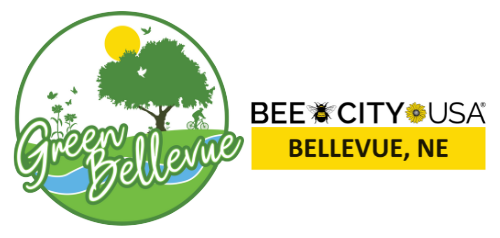
Bee City USA is an initiative of the Xerces Society for Invertebrate Conservation. Bee City USA provides a framework for communities to come together to conserve native pollinators by providing them with healthy habitat that is rich in a variety of native plants, provides nest sites, and is protected from pesticides. In March 2021, the City of Bellevue became the first Bee City USA in Nebraska.
Coming Soon!
Bee City USA Pollinator Garden Certification!
Using the Bee City USA framework - this initiative is charting a course for the City of Bellevue to increase the abundance of native plants, provide nest sites and reduce the use of pesticides through partnering with residents, businesses, schools, utilities and government to educate our community about the why, what and how to protect Bees and insects. Join Us!
NATIVE BEES
-

Bumble Bees (Genus Bombus)
Bumble bees are social, with colonies formed by a single queen. They nest in old rodent holes, under plant debris or thatch, or in other sites providing insulation. Unlike non-native honey bees, bumble bee colonies are annual (only lasting one year). At the end of the season, female bees find mates with males and find a protected site to overwinter (often underground). In the early spring, females emerge and provision their nests. Bumble bees are incredibly efficient pollinators of wildflowers and crop vegetables, partly because of their ability to buzz pollinate (vibrate to release pollen from flowers). Bumble bees are also generalist pollinators that visit a broad range of flowers.
-

Sweat Bees (Family Halictidae)
Sweat bees can be social or solitary. They typically nest in bare, compacted ground. They are extremely peaceful and very rarely sting. When they do, their sting is rarely painful. Some halictid bees are specialists, but the majority of species visit a wide range of native flowers.
-

Long-horned Bees (Melissodes sp.)
Long-horned bees can be identified by their unusually long antennae. They are solitary, peaceful bees that nest in the ground. Many Melissodes sp. are specialists on plants in the Asteraceae family, such as Helianthus (sunflower), Rudbeckia (black-eyed susan), or Solidago (goldenrod).
-

Leafcutter Bees (Family Megachilidae)
Leafcutter bees can be identified by their pointed abdomen. They are peaceful solitary bees that nest in cavities lined with leaves. They use their mandible to cut characteristic round segments from leaves to roll into cylinders as “sleeping bags” for larvae. Megachilidae bees are most frequently seen visiting native plants, including milkweeds and Liatris spp.
-

Cuckoo Bees (various taxa)
Cuckoo bees are unique in that they do not collect pollen for their own nests. Instead, they lay their eggs in the nest of other bee species. The host bee collects pollen that feeds their young as well as the nest parasite cuckoo bees. Although they do not actively gather pollen, cuckoo bees are important pollinators and are an indicator of a healthy habitat with plentiful host species present. Cuckoo bees can be identified by the lack of hairs on their legs (they don’t need to capture pollen).
OTHER CREATURES
-

Great Golden Digger Wasp (Sphex ichneumoneus)
The great golden digger wasp (Sphex ichneumoneus) may look intimidating because of its size, but it is perfectly peaceful. This wasp is a specialist hunter of certain species of katydids, so it is an important method for keeping these herbivorous species in check. Other wasp species specialize on particular caterpillars, spiders, or beetle grubs (including killing Japanese beetles in your lawn!).
-

Flower flies (Family Syrphidae)
A larval syrphid fly may not be very pretty, but they sure are beneficial for getting rid of aphids (as seen in the image here). Be eliminating pesticide use, you support beneficial predators such as syrphid flies to control pests. When you use pesticides, you eliminate predators. Because pests can rebound faster than predators from pesticide use, pesticide treatments can paradoxically cause more pest damage in the long run. As adults, syrphid flies are beautiful pollinators disguised as bees.
-

Long-Legged Flies
Another beneficial group of flies is the long legged flies. These flies are broad predators able to consume a wide variety of prey species.
-

Lacewings (Order Neuroptera)
Lacewings are an order of insects that are predators as both larvae and adults. Although you can order lacewings as a biological pest control agent for your garden, this is unnecessary and probably contributes to the spread of insect diseases. Instead, just create pesticide-free native plant habitat areas to support the life cycle of these beneficial insects. You will be rewarded by free pest control.
-

True Bugs (Order Hemiptera)
Some true bugs can be very important predators of pest organisms. The assassin bug (also known as a wheel bug) is not a threat to humans, but it has a powerful proboscis capable of stabbing and killing adult Japanese beetles. If you have a mature habitat with abundant insects, you might be lucky enough to support these wonderful predators. The assassin bug seen here is waiting on some backyard goldenrod for its next meal of Japanese beetles. These bugs are one of the few insects capable of eating the invasive beetle species (the others being some of the parasitoid wasps). If you have these in your garden, consider yourself lucky.

